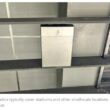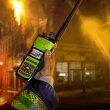Tunnel Vision
Signal coverage inside buildings or other hard-to-penetrate structures is a problem as old as wireless communications, but the incentive to solve the problem varies significantly. For a consumer using a cellular network, losing a signal may be nothing more than an annoying inconvenience. But for an enterprise user trying to execute a mission-critical application or a public-safety first responder in the midst of an emergency, whether in-building coverage exists can profoundly impact the bottom line or be the difference between life and death.
In an information-centric age, there is a greater need to connect wireless devices to networks for applications that continue to play a vital role for an increasingly mobile workforce. This explosion in the number of wireless devices — whether served by a commercial wireless carrier or a privately owned enterprise network — has created challenges, such as interference issues, that did not exist even five years ago.
“With the advent of data, people are making more complex waveforms, which means you need a better carrier-to-interference ratio than you had in the past,” according to Paul Simpson, vice president of business development at Spotwave Wireless.
Of course, this challenge will only exacerbate as the popularity of these wireless devices increases, meaning vendors that offer solutions to in-building coverage questions have a tremendous market opportunity. But while all vendors naturally express support for their companies’ technologies, they also agree there is no single in-building solution that works best in all cases. In addition, the proliferation of network options and the migration to IP-based transport for voice and data offer potential synergies in the future.
In-building basics
From a big-picture perspective, the technology to address the in-building coverage issue “really hasn’t changed in the last 20 years,” according to Chuck Jackson, vice president and director of systems operations for Motorola’s Commercial, Government & Industrial Solutions Sector.
A primary strategy still in vogue is one Jackson calls the “brute-force method — hit it with a 50-pound sledgehammer.” This requires a network to be designed so large towers encircle a building-laden territory; signals are then “blasted” into the developed area. With signals coming from myriad directions, at least some are likely to penetrate a given building to provide signal coverage in the structure.
However, while providing a solid coverage foundation, this tried-and-true strategy has several drawbacks.
First, erecting new towers to surround the developed area frequently involves a difficult political process that requires considerable monetary and personnel resources. Second, newer buildings often are outfitted with energy-efficient windows that deflect ultraviolet rays — and, unfortunately, radio signals.
“With newer buildings, the coatings on the windows are almost metallic, so it’s tough to get any signal through there, regardless of the spectrum,” Jackson said.
Finally, the simulcast-blast solution does nothing to address coverage issues deep in buildings or underground areas such as tunnels, basements and parking lots.
Andrew Corp. long has been a leader in helping wireless providers extend their networks to these hard-to-cover areas, particularly through the development of Radiax, or “leaky cable” — its trademark coaxial cables that include strategically placed slots that let the cable emit and receive radio signals before backhauling them to the primary network via the cable.
This cable comes in two different flavors, according to Greg Santee, director of the Americas for Andrew’s wireless innovations group.
Generic radiating cable indiscriminately transmits signals in a given spectrum range, such as 450 MHz to 1900 MHz, Santee said. Andrew also offers tuning cable, which works only with specific frequencies in a similar range — for instance, 450 MHz, 800 MHz and 1900 MHz. Tuning cable is more expensive, but its greater performance means fewer signaling points are required, which can make the overall solution cheaper, Santee said.
Radiax works well in tunnels and underground parking lots, where an exposed wire can be protected from the elements and the signal does not encounter many barriers. In office environments with walls and cubicles in relatively tight quarters, an increasing number of carriers wanting to improve in-building coverage have opted for distributive antenna systems during the past couple of years, Santee said.
With multiple signaling points, distributive antenna systems can be designed to target hard-to-cover areas and provide some redundancy, if desired, Santee said. The signaling points are networked via Cat. 5 cable or fiber wiring that serves as a conduit to the core network. Santee said less than 10% of buildings have available fiber, but those that do have a tremendous advantage.
“The nice part about fiber is that, once it’s in the building, you may have to change active elements and electronics, but you won’t have to pull wires because you have so much bandwidth,” Santee said. “Your building will be set for the next 30 years.”
For years, cost was the primary barrier for years for fiber and distributive antenna systems, but that’s not as much of a problem today. Not only have the technologies dropped in price, but enterprising building owners and carriers have discovered that multiple providers often are willing to share the expense, Santee said.
“Another enabler is that [distributive antenna systems] can also broadcast wireless LAN,” Santee said. “I think, as there are future developments in other bands, there will be more sharing of costs.”
Getting smarter
But all these wireless developments can increase the likelihood of interference or performance deterioration that requires significant network design and installation know-how to resolve. In addition, the cost of technical resources needed to design traditional distributive antenna systems was outside the price range of customers wanting in-building coverage for an area of 100,000 square feet or less.
“Those kind of systems [also] don’t have cognitive abilities,” said Spotwave’s Simpson. “That’s important because the RF environment is a dynamic environment, while traditional solutions are static.”
Recognizing the situation, Simpson co-founded Spotwave with President and CEO Shane Young. The plan was to make adaptive repeaters that use smart-antenna technology to provide wireless in-building coverage solutions that made economic sense in buildings that are less than 100,000 square feet.
“The concept was to make a repeater that anyone can install without knowledge of the network and without test equipment,” Simpson said.
And Spotwave repeaters are designed to reduce future maintenance costs, Simpson said. Spotwave’s software lets its repeaters continuously scan the spectrum for desired carriers and automatically adjust to changes in the RF environment, whether it involves noise from another wireless device or growth of leaves on trees that can impact coverage in a given area.
“Eventually, we believe that all repeaters are going to have intelligence,” Simpson said.
Perhaps nowhere is it more important for repeaters to recognize the surrounding RF environment than in a hospital, where stray radio signals can upset the performance of sensitive medical equipment that monitor patient health. That’s why Sprint is using Spotwave repeaters in conjunction with Cisco’s Aironet system to provide a complete wireless solution that integrates the Wi-Fi network at the University of California-Davis’ 1 million square foot hospital campus with Sprint’s 1XRTT network.
At the heart of that system is technology from Vocera Communications that lets hospital personnel engage in instant voice-activated voice-over-IP conversations using a Star Trek-like communicator (see photo at right).
With a simple nurse’s voice command such as “Call Dr. Henderson,” the Vocera system instantly establishes a VoIP link between the nurse’s badge and the doctor’s badge. If the doctor is not in the hospital, the system automatically calls the doctor’s cell phone, office phone or home phone until it finds him. Meanwhile, the nurse can stay at the location, instead of using the hospital’s paging system or having to find a phone to execute the communication.
“It’s a huge time saver,” said Brent Lang, Vocera’s vice president of marketing, who noted that a company study in one hospital revealed 3400 hours of time savings per year for one nursing unit. “In addition, we found that the amount of overhead [intercom] paging was reduced by 94%. That means the patients are able to sleep better and recover.”
The Wi-Fi way
While Vocera currently is focused on the health-care sector, Lang said recent interest from retailers and manufacturers has convinced the company its communications system has applications in multiple enterprise environments.
Certainly the concept of extending coverage by leveraging private Wi-Fi networks is gaining momentum. Earlier this summer, Motorola, Proxim and Avaya announced a solution that would allow an enterprise user to seamlessly switch from using a cellular network to an enterprise’s Wi-Fi network for mobile voice and data applications upon entering the enterprise campus. Offloading cellular calls to the Wi-Fi network lets enterprises realize savings in their mobile phone bills while providing in-building mobile-phone coverage, even in hard-to-reach areas such basements, according to Motorola director of marketing Bob Duerr.
“We’ve trialed it inside our own building,” Duerr said. “It makes life so much easier. You don’t have to worry about [in-building coverage]. You don’t have to head for a window every time you get a call.”
Given Motorola’s market dominance in the public-safety market, it was only natural for the vendor to consider a plan that would let first responders take advantage of existing Wi-Fi networks to extend radio coverage in buildings. But, as is the case with all in-building solutions, there is no one-size-fits-all answer — an industry truism reiterated to Motorola’s Jackson when the company presented the plan to a public-safety communications group.
“We were all excited and thought, ‘We’ve finally got this thing [in-building coverage] figured out,’” Jackson said. “When we finished our presentation, a fire chief in the back of the room raised his hand and said, ‘That’s nice, but do you know what the absolute first thing we do when we enter a building? We rip out the false ceiling to ventilate the fire and pull down all the wires.’”
Of course, the collapse of those wires would mean the collapse of the Wi-Fi-based in-building solution. Jackson shook his head with disappointment as he recounted the episode several weeks later. Although ideas such as networking access points via a wireless mesh instead of wires is being considered, Jackson indicated solving this particular in-building challenge will require a trip back to the drawing board.
Public-safety alternatives
In the meantime, public safety will continue to use more traditional strategies to enhance in-building communications. The most rudimentary of these is to use the in-building emergency phone system, which can be particularly helpful in high-rise buildings. Another solution is the deployment of repeaters within buildings — something that is part of the building code in some communities.
In addition to these in-building alternatives, public-safety agencies also can opt for mobile solutions such as M/A-COM’s V-TAC, a vehicle-based communications system with a fully functional mobile radio that provides voice, data and GPS services, according to Dennis Martinez, M/A-COM’s vice president of technology.
When inside a building, a first responder’s portable radio signal deteriorates because of structure interference, the portable’s lack of power and because the user’s body absorbs some of the radio energy — a combination that can render a portable useless, particularly if the fixed base station is far away.
With this in mind, M/A-COM created the V-TAC system, which serves as a mini-cell site at an incident for portable radios on the company’s OpenSky network, Martinez said. The strategy is particularly effective because the V-TAC often is not in the building; it has a larger antenna that allows for signal transmissions with significantly more power than a portable and there generally is no human body near the antenna to absorb radio waves.
“When a [portable] radio loses coverage with the tower, then it goes through the vehicle to get back to the network,” Martinez said.
Of course, M/A-COM was a pioneer in public-safety-grade VoIP. With all forms of communications migrating to an IP platform, opportunities for providers to piggyback off each other’s investments abound — a strategy that also can help defray costs previously borne solely by a single provider. Martinez expressed particular interest in the notion of public safety leveraging available private Wi-Fi networks to enhance in-building coverage.
“That’s an interesting future product concept,” Martinez said. “That kind of product doesn’t exist today to reconnect to the network, but it’s just a matter of time.”

















